Insightful newsletter of Drishtikone: Issue #148 - Ways of pre-British Indian Bankers and how India lost
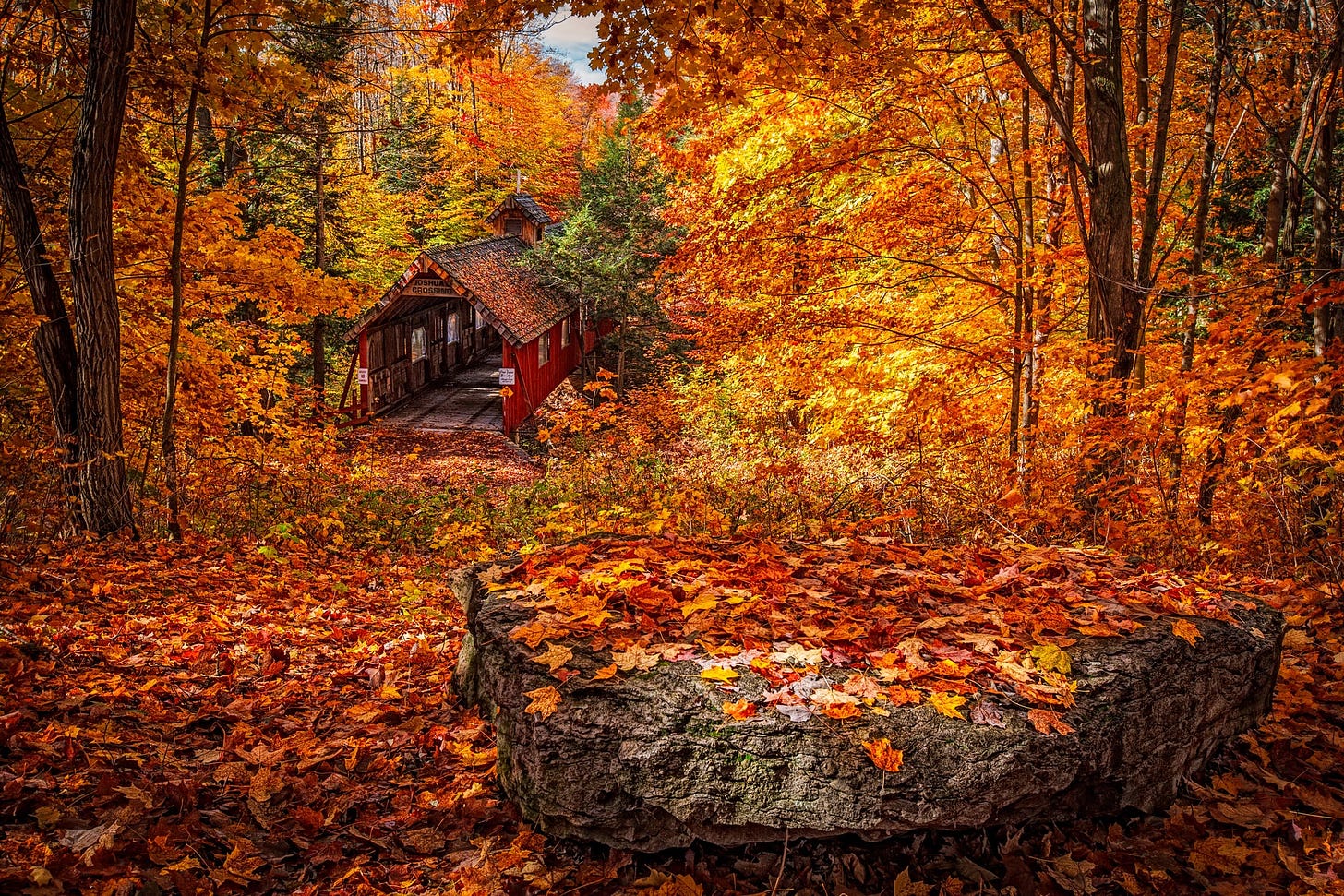
(Photo by Dennis Buchner on Unsplash)
“Autumn is a second spring when every leaf is a flower.” ― Albert Camus
We are the sum total of our ancestry. What the generations feared, loved, shunned, fought was embedded in their DNA and our genealogy. That is why our ancestors had “kula devta” temples, where the prana pratisthta of the kula devta murtis was done with the specific purpose of a certain genealogical type. And, the marriages were restricted in a way to keep the family DNA intact. Not to assert superiority, but to ensure well-being.
All that is gone. But the principle of nature and science remains intact. Even environmental factors that create certain reactions in us can be embedded in our DNA and passed down for generations. A provocative study done on mice showed that when the mice were given electric shock while their chamber was filled with the smell of acetophenone, they associated fear with that smell. A reaction that was passed on to subsequent generations. It passed from both father’s side as well as the mother’s side.
This reaction was passed on to their pups, Dias and Ressler report today in Nature Neuroscience1. Despite never having encountered acetophenone in their lives, the offspring exhibited increased sensitivity when introduced to its smell, shuddering more markedly in its presence compared with the descendants of mice that had been conditioned to be startled by a different smell or that had gone through no such conditioning. A third generation of mice — the 'grandchildren' — also inherited this reaction, as did mice conceived through in vitro fertilization with sperm from males sensitized to acetophenone. Similar experiments showed that the response can also be transmitted down from the mother. (Source)
So, all the terror, the genocides, the mistakes, the wars, and the betrayals that were done in the times of our ancestors created certain reactions in them. Even till today, we all are reacting to our share of the ‘smell of acetophenone’, not to the actual electric shock. That is why history is so critical to understand.
the mystery of the ‘Hindu baniya’
In this clip, Sohail Tanvir, a Pakistani cricketer displays his anti-Hindu bigotry by blaming the “Hindu” for action by the Indian government of not allowing the Pakistani cricketers to be allowed in cricket’s IPL. And this male anchor calls this dismissively as “Hindu baniye ki zehniyat.”
If you have ever listened to the many Pakistani bigots who openly display their Hindu hatred, you will hear a common refrain to target Hindus - the Hindu Baniya.
While Christians go after the Brahmins - because during the British time the missionaries found it tough to convert the Brahmins so they reserved the vilest of words for them - have you ever wondered, why the Muslims and, specifically Pakistanis, identify Hindu “villains” as Baniya?
Let us look into that today.
Bankers of the pre-British time and how India lost
How was money handled in pre-British days? When there were no banks and no financial institutions, who did the lending and financing of activities in any state/kingdom?
And, more importantly, how the entire structure, short-sightedness, and greed sunk India’s destiny.
It had become well-known by the mid-1800s that 75% of the country was held in one way or another by Arabs and Pathans. (Source)

Money had been controlled in Hyderabad, as in most of the country, by these main financial families. They would employ strong men to safeguard them. These bodyguards and militia were basically the Afghan Pathans and the Arabs.
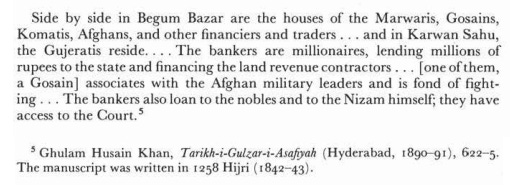
These Sahukars would lend the money to the state for it pay the salaries. Whom they lent and how much would often establish the credit-worthiness and even credibility within the society. They could, therefore, influence administrations and Diwans in any district and state.
Hyderabad’s financial world was completely controlled by the Hindu families, some of whom had come from North and Western India.
Their control would pass from one generation to another and often split within the family itself.
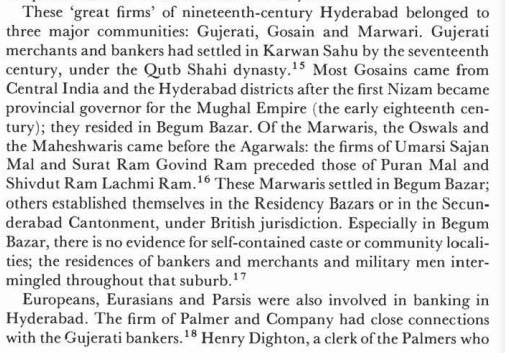
The major banking firms - or those involved in financial transactions included the Gujaratis, Marwaris, and Gosains. The Parsis also entered this area later.
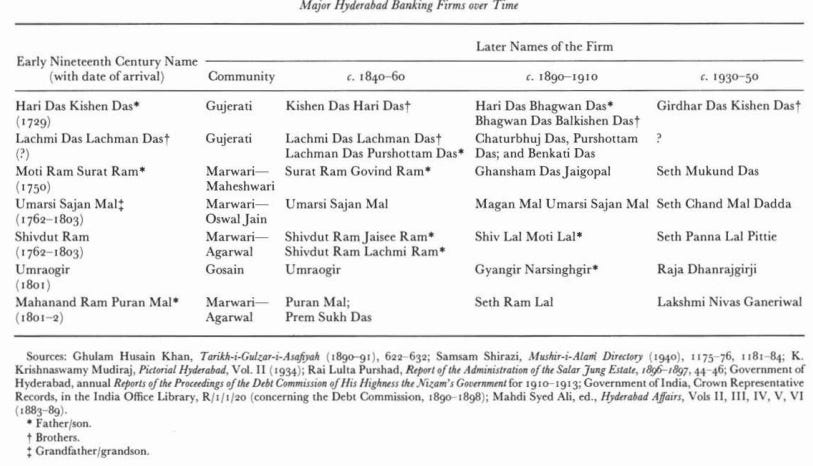
By the 1840s, bankers or Sahukars were not the only ones who would deal with money and finances. Even Talukdars, who were collecting taxes, often in excess of the state-mandated amount, and the military leaders who provided protection and held land were engaged in financial transactions.
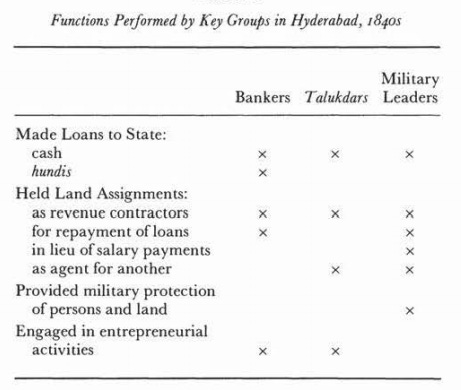
Hundis, or the IOUs were used only by the Sahukars. In the end, that proved to be their downfall. As the kingdom floundered and the state was becoming unable to pay its dues that it owed, repayment of loans to these Sahukars/Bankers was becoming impossible.
The only ones who were being paid - the military commanders. The Afghan Pathans and Arabs. The Sahukars and even the Parsi seths were going bankrupt.
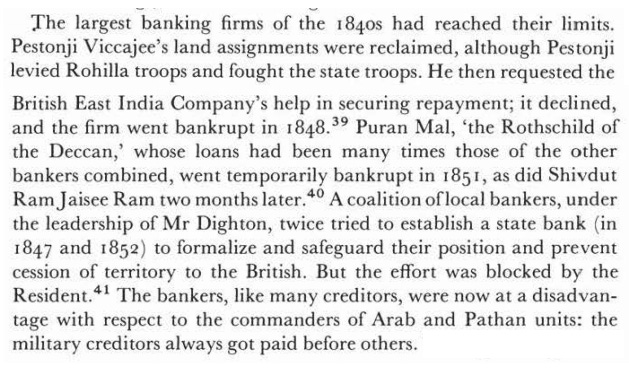
The impact of these politics and the emergence of Salar Jung (in whose name there is a museum in Hyderabad), created the situation for the defeat of the revolutionaries in the War of 1857.
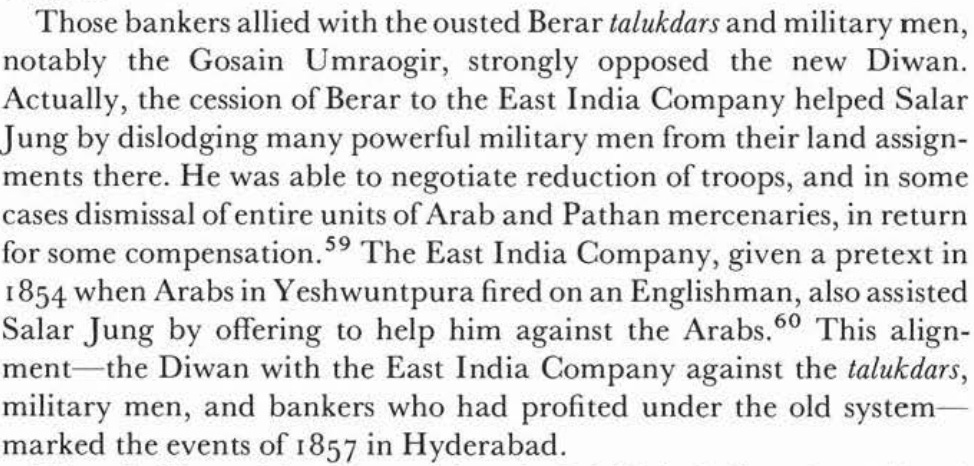
So, it wasn’t just a war on the battlefield but the games played behind the scenes which defeated the Indians in 1857.
In a subsequent edition, we will discuss how even though the overall national GDP share of India in the world may not have changed that much post-Islamic period, the distribution of wealth changed drastically. Ultimately, making it easier to loot those focused concentrated “centers” of wealth and impoverish the entire nation. What Mughals sowed, the British reaped.
Also, do you see why the Muslim feudal lords - the Talukdars and zamindars - found the Sahukars - the Hindu baniya - so inconvenient and formidable? Enough to pass the hatred against them down to the future generations!
Food option in Delhi
Today let us start with something that will help someone and is a positive use of social media. There is a small ‘hole-in-the-wall’ Dhaba run by an elderly couple - in their 70s-80s - in Delhi’s Malviya Nagar. Their address is - Himanshu Daya Shankar Pandey Baba ka Dhaba, Site number 12322 Ward number 63 Aan Nala Hanuman Mandir. One hasn’t tasted, but from the look of it, the food looks great.


What is needed is an aggregation platform for the non-regular food businesses like these, so that people can book food and get them from these sites. The aggregation company can either call them or hook them up with smartphones to get the food ready for pickup by the customer.
the Hathras riot act of Congress
The cat is out of the bag now. The right-hand man of Rahul Gandhi shares how he has a lot of people at his command to engineer riots in Hathras. He is looking at the procurement of weapons and says openly how “many will be slaughtered.”
The TimesNow, meanwhile, talked to the village people, who are sharing the same story of the love relationship between the accused and the victim.
Remember these things when Hathras is discussed.
nota bene
India is a global leader in Financial transactions: Thanks to the pandemic, the country has become the global leader in real-time financial transactions with 41 million transactions per day, which is more than double that of the last year, says an international report. But in terms of the growth rate, the list is topped by Bahrain with 657 percent growth, followed by Ghana clipping at 488 percent, the Philippines growing at 309 percent, Australia at 214 percent, and Poland at 208 percent. (Source)
India and Japan sign 5G tech agreement: India and Japan have finalized an ambitious agreement that provides for cooperation in 5G technology, artificial intelligence and an array of other critical areas as the two strategic partners vowed to further broad-base their ties including in the Indo-Pacific region. After a meeting between External Affairs Minister S Jaishankar and his Japanese counterpart Toshimitsu Motegi in Tokyo on Wednesday, it was announced that Japan agreed to be the lead partner in the connectivity pillar of the Indo-Pacific Oceans' Initiative (IPOI). The IPOI is an India-backed framework aimed at making meaningful efforts to create a safe and secure maritime domain in the Indo-Pacific, a region where China has been expanding its military assertiveness triggering global concerns. (Source)
US COVID vaccine could be delayed: The U.S. Food and Drug Administration (FDA), overcoming the White House’s initial opposition, released new safety guidelines Tuesday for drugmakers working for months on developing a Chinese virus vaccine. The move could prevent or delay introducing a potentially safe and effective final product before Election Day and beyond. (Source)
India’s networking market to grow by 5.2% CAGR: The India enterprise networking market is projected to grow at a CAGR of 5.2% in its market value between 2019 and 2024 following a temporary decline in 2020, said a new report by analytics firm GlobalData on Wednesday. GlobalData said it forecasts the enterprise networking market in India to decline from $8.42 billion in 2019 to $8.35 billion in 2020. (Source)
Goa you have never seen before - where Rishis meditated
I love watching travel videos of people. Most of them are forgettable. This one by Meiyang Chang, an Indian Idol finalist (5th), is awesome. Meiyang has clear diction, is very articulate, and has some interesting perspectives on the places he visits.
Do check it out and see a very different Goa than you have imagined. A Goa which showcases the places that were inhabited by the amazing Rishis and Yogis.
Today’s ONLINE PAPER
Check out today’s “The Drishtikone Daily” edition.
Support Drishtikone
If you consider our work important and enriching and would like to contribute to our expenses, please click on the button below to go to the page to send in your contribution. You can select the currency (for example, INR or USD, etc) and the amount you would like to contribute.
If you like this post - please share it with someone who will appreciate the information shared in this edition -
If you like our newsletter, please share it with your friends and family -



